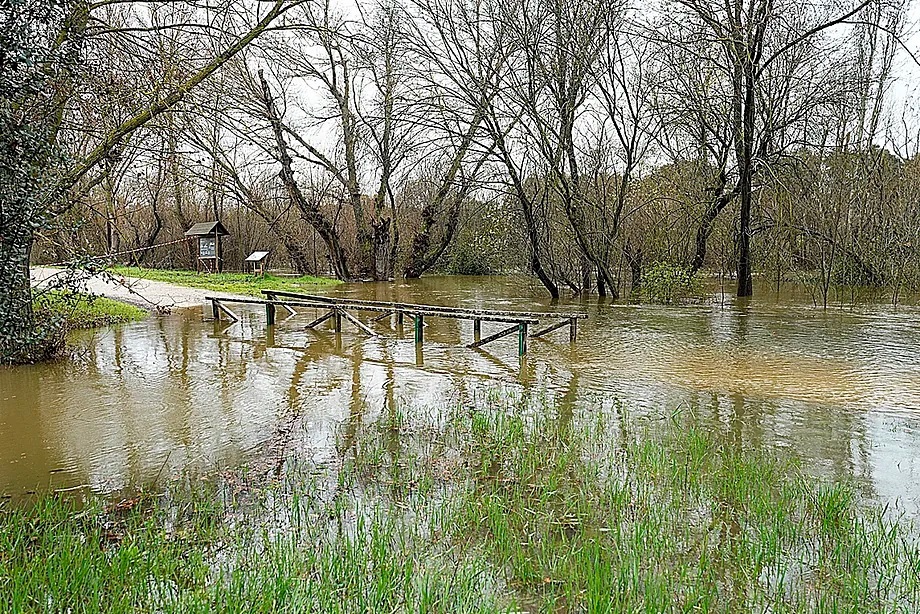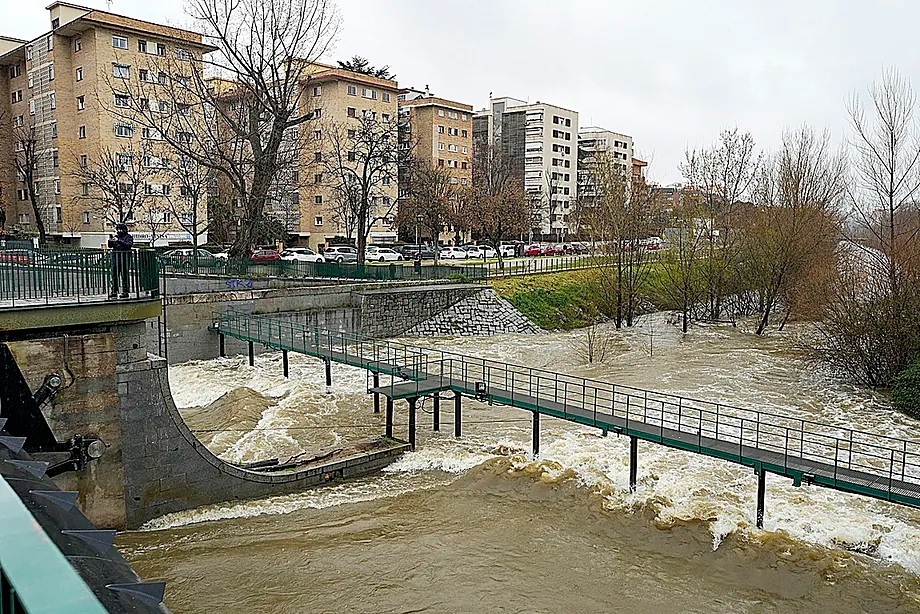The rainiest March in Madrid's history keeps the region and the capital on edge. The downpours of the last three weeks continue to cause maximum alert due to the rising levels of rivers and streams and the releases from the 13 dams of the Canal de Isabel II. The levels of the Alberche, Jarama, and Manzanares tributaries keep increasing, leading to overflows in Madrid, Villalba, Galapagar, Titulcia, El Escorial, and Rivas. And in the coming days, the situation could worsen due to the combined effect of new rainfall and the melting of all the snowfall in the mountains as a result of rising temperatures.
According to AEMET data, with only 18 days counted so far, this month is set to be the rainiest March in the history of the capital. As of yesterday, 188 liters per square meter were recorded at the Retiro station, surpassing the previous record of 140 liters per square meter for the entire month of March in 2018.
In the capital yesterday, the water level of the Manzanares River rose to the point where the City Council prohibited pedestrian access to the unchannelized riverbanks in the city, from Mingorrubio to the Puente de los Franceses. "There are riverbanks that are dangerous for pedestrians," stated the Madrid City Council.
The rise of the Manzanares River was partly due to the El Pardo dam of the CHT starting to release 30 cubic meters of water per second, compared to the previous days' 14 m³. Residents say they have never seen the Manzanares River like these days, with the lock area open and the Mingorrubio footbridge flooded.
At the Capuchinos de Fuencarral bridge, dozens of people gathered to capture the power of the water on their phones. "Normally, there is a trickle of water passing under the central arch of the bridge. It's spectacular to see it like this with the entire riverbed full," said a resident. Yesterday, the rise also forced the closure of the Puerta de Hierro Sports Park and the Somontes Hockey Sports Complex. The Municipal Police have marked several points and are monitoring flood-prone areas of the Manzanares River with the help of drones. The Madrid City Council decided to keep the level 1 Flood Plan activated, and the Deputy Mayor of Madrid, Inma Sanz, explained that "the El Pardo reservoir is being significantly discharged, affecting the course of the Manzanares River." They are also closely monitoring the Jarama River, specifically in the Rejas and La Muñoza areas.
In the Community of Madrid, the most critical situation remains in the Guadarrama River basin, in Villalba and Galapagar, and in Titulcia with the Jarama River overflowing. The Regional Flood Plan's emergency phase 1 remains in effect, activated on Monday.
The Madrid Regional Minister of Environment, Agriculture, and Interior, Carlos Novillo, explained yesterday after a crisis cabinet meeting of the 112 emergency service that "the worst is currently in the western area," where a significant amount of rain accumulated, and emergency services are now monitoring the Guadarrama River for any further rises. Members of the Tajo River Basin Authority and Canal de Isabel II also participated in this meeting, explaining their forecasts for the dam releases to maintain that safety margin for water security and dam safety.
For today, Wednesday, the rain is expected to cease, with another front announced for tomorrow that will bring fewer showers. "We are going to enter a period of relative calm, with the evident tension that we have to monitor these rivers on soil that can no longer absorb more water" because "all the soils are already saturated."
The Madrid Minister indicated that there are "historic accumulations" of snow in the mountains, with nearly three meters on the peaks, "which need to be monitored because the accumulated water, rainfall, and high temperatures can affect the headwaters of the Lozoya River. In Titulcia, the overflow of the Tajuña River, exacerbated by the La Tajera dam release, transformed the fertile lands of the village, known as "the land of garlic," into a flooded landscape resembling a rice plantation. Over 100 hectares of crops, including garlic, cereals, peas, and barley, are submerged, leaving farmers on the brink of ruin with estimated losses in the thousands of euros.
Roads also suffered from the rain, with the M-611 in Rascafría, the M-600 in El Escorial, and the M-622 in Guadarrama being closed yesterday.

